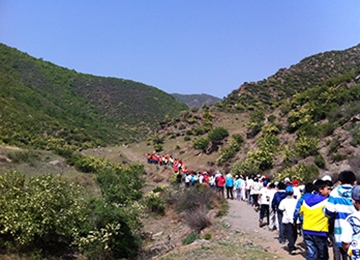I grew up in a small town called Hohhot in Inner Mongolia, China. Hohhot is a Mongolian name meaning “the green city.” Indeed, in ancient times, it must have been very “green” as people would draw big white circles on exterior walls to scare away the wolves! So the air must have been very clean then as it was when I grew up, since I could distinctly see a blueish mountain from our front yard, called “Daqing Shan,” meaning the Great Blue Mountains. When I was about seven years old, I decided one day that I would walk to the mountain and check it out myself. I could still remember my mother’s panic when I told her my plan. “Min, the mountain is actually far, far away!”
Unfortunately, my home town has experienced tremendous growth since then, more people, more industry and more pollution. By the time I was in college, Daqing Shan had completely disappeared from view. It was not until two decades later, in 2010, when I visited my parents in Hohhot that I saw Daqing Shan again. Almost immediately, tears were welling up my eyes. How I missed her!
As it turns out, my hometown started using coal powered plants about 10 years ago. Unfortunately, unlike in the US, the plants did not scrub the emissions resulting in lots of soot hanging in the air that settled on every surface. Today, street lights are powered by solar energy, and heating uses geothermal energy. These changes have tremendously improved the city’s air quality.
Based on data published by United Nations, when the Earth Day celebrations first began in 1970, the world’s population was at ~3.7 billion. Now we are about to celebrate Earth Day again, and the world population has more than doubled at ~7.5 billion. In addition, the world is gaining ~1 billion people every 10 – 15 years. Obviously, there is tremendous pressure for economic growth to meet the basic needs for everybody. That is why the balance between environmental protection and economic growth has been a constant struggle for almost every government.
While pollution could be grandiosely viewed as the byproduct of economic growth “for the people,” we all have a role and responsibility to preserve our limited resources that people depend upon. Otherwise, the quality of life and people’s health could drastically decline, just like what happened in my hometown. But my hometown’s steps to curb pollution and improve the quality of life is an example of what can be done – which is what Earth Day celebration is all about. Are we doing our part?
Author: Amy Yimin Fu, P.E. is the Environmental Group Manager for Ellis & Associates, Inc. (E&A), an ECS Group of Companies. Her expertise includes contamination assessment and remediation of petroleum, chlorinated solvent, metals, and polychlorinated biphenyls (PCB) impacted soil and groundwater, environmental permitting and compliance, groundwater modeling, and remediation systems design. She holds a Master of Science in Chemistry from the University of Notre Dame, a Master of Science in Chemistry from Xiamen University, China, a Bachelor of Engineering – Chemical Engineering from Tsinghua University, China, and is currently pursuing her PhD in Environmental Engineering from the University of Florida.

